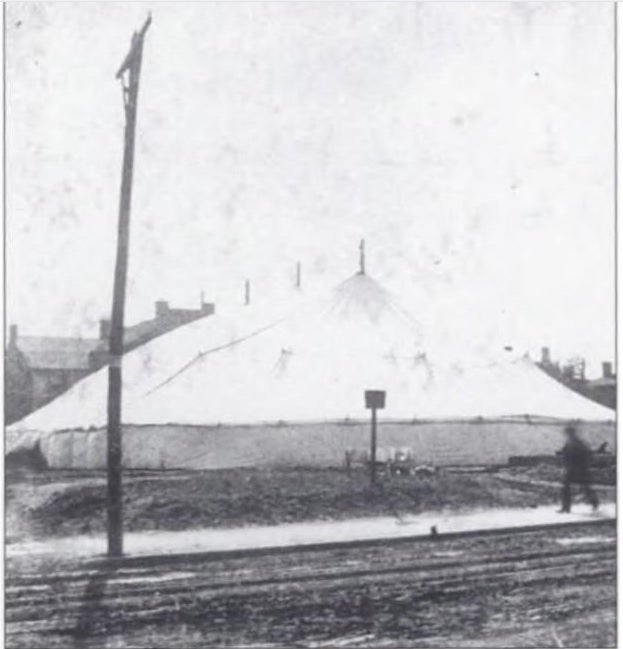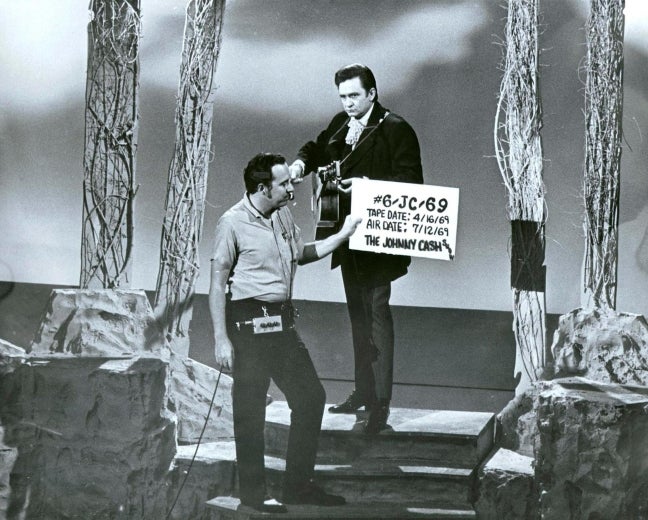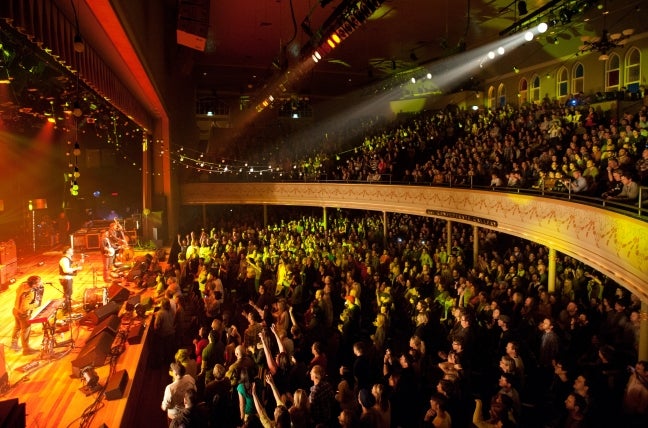Did Ryman Auditorium Used to be a Church?
Ryman Auditorium was originally built as a church in 1892. Called the Union Gospel Tabernacle, the church was the inspiration of Thomas G. Ryman, who felt called to build it after attending a tent revival by evangelist Rev. Sam Jones. The building’s usage has evolved over the years, as has its name, but it’s always been a place that transforms and inspires everyone who walks through its doors.
How Ryman Auditorium Began

Ryman Auditorium was built because of the vision of one man, sea captain Thomas G. Ryman. After he attended a tent revival led by evangelist Sam Jones, Ryman was inspired to dedicate his time and fortune to building a church just blocks away from the site of the revival. The Union Gospel Tabernacle opened in 1892.
At the time, the church was the largest structure of its kind in Nashville, so it also quickly became the location of many other community events, including lectures, fundraisers, meetings, musical performances, and more. The world’s most famous performers of their day stepped onstage at the Ryman, including Harry Houdini, Mae West, Charlie Chaplin, and Katharine Hepburn. When Tom Ryman died in 1904, the church was renamed Ryman Auditorium in his honor.
The Ryman's Evolution Over the Years

In 1943, a popular, live radio show called the Grand Ole Opry moved to Ryman Auditorium. It had outgrown its previous four homes, most recently the War Memorial Auditorium, and the Ryman had just enough clout and space to fit the show’s sold-out crowds.
It was during its years at the Ryman that the Grand Ole Opry gained notoriety across the U.S. featuring performances by a star-studded list of performers like Minnie Pearl, Patsy Cline, Bill Anderson, Johnny Cash, Dolly Parton, Hank Williams, and more. In fact, the Ryman played a critical role in launching many country stars to fame, making them household names through their performances on the Ryman stage. Ryman Auditorium was home to the Grand Ole Opry for over 30 years.
The Ryman was also the site of many significant moments in music history. In 1945, a performance by Earl Scruggs with Bill Monroe’s Blue Grass Boys introduced a new musical sound to a large audience. It was a perfect combination of banjo, bass, guitar, mandolin, and fiddle, and its popularity spread across the U.S. Bluegrass was born. The Ryman is also where the Man in Black, Johnny Cash, and his wife, June Carter, met. When they were introduced backstage in 1960, Cash proclaimed, “I’m going to marry you someday.”
In the 1970s, it was determined the Grand Ole Opry needed a permanent home of its own, so construction of the Grand Ole Opry began. The show left Ryman Auditorium in 1974, and with an unclear use and future, the Ryman fell into disrepair. In the years that followed, the building came perilously close to being demolished but was saved at the last hour thanks to a team of musicians and Nashville locals who banded together to preserve the historic site. Efforts began in the early 1990s to restore Ryman Auditorium to its former glory. Today, the venue is known as one of the best in the country and stands as a living museum and icon of Music City.
How is Ryman Auditorium Used Today?

130 years after its doors first opened, Ryman Auditorium still stands proudly in downtown Nashville. While the city has changed around it, the venue has remained an icon of Music City and a beacon of music history. Today, audiences flock from all over the world to experience the Ryman, whether it’s to see a concert or take a tour.
Concerts, Shows & Events
Ryman Auditorium is one of the most well-known and well-loved music venues in the world. Its roster of shows goes way beyond country music with concerts spanning rock, indie, hip hop, and folk genres, as well as a regular lineup of comedians and speakers. It’s also home to annual special events, like Amy Grant & Vince Gill’s Christmas at the Ryman. Check out the Ryman’s show calendar to see when your favorite artists are performing.
Tours
Experience the rich history of Ryman Auditorium and the talented performers who have played there when you take a tour. Each tour starts in the Soul of Nashville theater with an immersive, star-studded video with choreographed light and sound design. Then, explore the Ryman’s exhibits. Take a self-guided tour to explore at your own pace, or book a guided backstage tour to get exclusive access to the venue’s dressing rooms, backstage, and wings of the stage, all with a knowledgeable tour guide. End your visit with a chance to stand on the famous Ryman Auditorium stage where entertainment greats have stood before you.
FAQS
Who Was the Ryman Named After?
Ryman Auditorium was named after Thomas G. Ryman, a sea captain who dedicated his fortune to constructing a church originally called the Union Gospel Tabernacle. After Ryman’s death in 1904, the building was renamed in his memory.
When Was the Ryman Constructed?
Construction of the Ryman started in 1885 and it opened in 1892 as a church called the Union Gospel Tabernacle.
Why Was the Ryman Built?
The Ryman was the inspiration of sea captain Thomas G. Ryman, who felt called to build a church in Nashville after attending a tent revival. Partnering with charismatic evangelist, Rev. Sam Jones, the church opened its doors in 1892 as the Union Gospel Tabernacle.
Why Does the Ryman Have Such Good Acoustics?
Ryman Auditorium has great acoustics because it was originally built as a church, perfect for projecting voices and music throughout its auditorium. The result is a sound that’s unmatched by any other venue in the world, making it a favorite performance venue for many artists.
Why is the Ryman So Famous?
The Ryman is famous for being the Mother Church of Country Music, the birthplace of bluegrass, and the original home of the Grand Ole Opry. It’s where countless music careers were launched. It’s a unique musical venue constructed with stunning acoustics and 130 years of history.
Did the Grand Ole Opry Used to be a Church?
No, the Grand Ole Opry wasn’t a church, but the Ryman was. Ryman Auditorium was originally built as a church called the Union Gospel Tabernacle in 1892. The building was renamed Ryman Auditorium in 1904 after Tom Ryman, the sea captain whose idea it was to build the church, passed away. In 1943, the Grand Ole Opry moved into the Ryman where it stayed for over 30 years before relocating to its permanent home, the Opry House.
What is the Difference Between the Ryman & the Grand Ole Opry?
Ryman Auditorium and the Grand Ole Opry have a long, shared history, but they are different.
The Ryman was constructed as a church in 1892 and served as a cultural center for the city and the home of the Grand Ole Opry. Today, it’s a world-renowned performance venue with concerts spanning musical genres. The Opry was opened in 1974 as the permanent home of the Grand Ole Opry show. It also hosts concerts by popular country music stars and is known as the True Home of Country Music.
Why Did the Grand Ole Opry Move Away From the Ryman?
The Grand Ole Opry moved to the Opry House in 1974 because the show needed its own, permanent home. Ryman Auditorium was home to the Grand Ole Opry for more than 30 years.
What Are the Best Options for Visiting the Ryman?
The Ryman offers a variety of tours every day. Take a self-guided tour to see the venue, exhibits, Hatch Show Print Gallery, and stage at your own speed, or book a guided backstage tour to get all the benefits of the self-guided tour, plus backstage access and behind-the-scenes stories from a knowledgeable tour guide. The Ryman also offers post-show tours and package deals with the Grand Ole Opry. To learn more about these options, how much they cost, and more, visit Ryman.com.
Is the Ryman Tour Really Worth Taking?
Yes! With 130 years of history, Ryman Auditorium has played an important role in country music history and in the city of Nashville. Touring the Ryman isn’t just one of the best things you can do in Nashville, it’s also a good value.
Sign Up for Alerts
Stay in the know on the latest Ryman Auditorium events. Sign up for email alerts and never miss a moment.
Stay in Touch
What’s almost as iconic as visiting the Ryman? Always having the inside scoop!
Sign up for exclusive updates, offers, and events, so you never miss out on what’s happening at the Mother Church.





